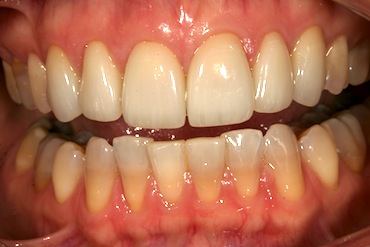Correction of Misaligned Teeth with Restorations
By Robert Winter on May 14, 2018 | 2 commentsWhen a patient presents with misaligned teeth and is seeking a prosthetic answer to their clinical situation (instant orthodontics with no other structural, functional, or esthetic problem), it is important to consider presenting orthodontic treatment as a first step in the restorative process.


Orthodontic treatment allows for changes in tooth position, bone, facial gingival tissue and papillae. Horizontally moving teeth can change tooth position and arrangement. Tooth proportion changes can be planned which may require opening or closing interdental spaces. By vertically moving teeth, the tooth position, gingival level and papillae heights can be altered. Proclining or retroclining teeth can impact the occlusion and possibly create a situation where less tooth reduction is necessary if restorations are planned.
The patient may have already excluded orthodontics as a treatment option, but including this alternative is an important part of your comprehensive treatment planning and informed consent process. There can be significant limitations to the esthetic, structural, or functional outcome when correction of misaligned teeth is performed only with restorative treatment. Potential limitations in the outcome include those related to:
- Tooth position
- Tooth arrangement
- Tooth proportion
- Gingival levels
- Papilla heights
The outcomes that are most predictable are when minor tooth arrangement, rotation, or space closure changes are desired. The more crowded the dentition, the narrower the restorations will be to straighten the tooth alignment. This may negatively impact the tooth proportion.
Without orthodontic movement of the teeth, there may also be compromises in papillae height. The closer together the roots, the shorter the papilla will be and the longer the interdental contact. The most significant consequence of restoring teeth without prior orthodontic alignment is the amount of tooth reduction that may be needed to accomplish the goals of the case. The aspects of the tooth that will most likely be impacted are:
- Incisal edge reduction
- Palatal/lingual extension may require a crown preparation rather than a veneer
- Labial surface in the incisal third may need to be more extensively prepared
- Labial surface in the gingival third may need to be more extensively prepared
- Interdental finish line location may need to be positioned more palatally
- Interproximal gingival finish line may need to be positioned deeper intracervically
The most appropriate time to consider the correction of misaligned teeth through restorative therapy is when the patient has structural, functional, or other esthetic indications, and the teeth will require restorations to correct the problem.
Comments
July 24th, 2013
July 24th, 2013